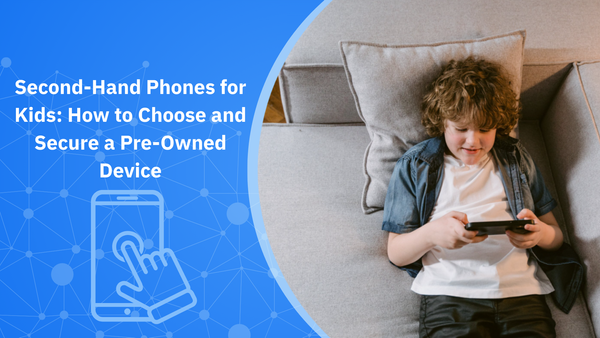Second-Hand Phones for Kids: How to Choose and Secure a Pre-Owned Device

Buying a second-hand smartphone for your child can seem like a great idea. It's cheaper, better for the environment, and often a good first step into the world of personal devices. But before you hand it over, it's important to know what risks might come with it — and how to make sure it's safe.
In this guide, we'll walk you through how to pick the right second-hand phone, what to do before your child uses it, and how to keep their data and privacy protected.
Why buy a second-hand phone for your child?
Buying a second-hand smartphone can make a lot of sense if your child is just starting to use one. It's often much cheaper than buying a new model, which is helpful if you're not sure how careful they'll be with it. Kids drop things, forget them, or lose interest quickly, so there's less pressure when the device doesn't cost a fortune.
It's also a more eco-friendly choice. Giving a used phone a second life helps reduce electronic waste and supports more sustainable tech habits. And from a parenting perspective, it can be a great way to teach responsibility. Your child gets the benefits of having a phone without you worrying about the price of replacing an expensive new one if something goes wrong.
Related: When Should a Child Get Their First Smartphone?
Risks of second-hand smartphones
A second-hand phone might look fine on the outside, but it can come with hidden problems that could affect your child's safety and privacy.
For example, outdated software. If the phone is too old, it may no longer receive updates from the manufacturer, which means it could have security holes that hackers already know how to exploit. Another issue is leftover data. If the previous owner didn't wipe the phone properly, it might still have personal files, apps, or even malware lurking in the background.
In some cases, the phone may have been tampered with — for example, modified to hide damage or appear newer than it really is. There's also a small but real chance the phone was stolen, which could lead to problems down the line if the IMEI number is blacklisted. And finally, if the device's privacy settings aren't checked and adjusted, it might still be sharing your child's data without you realizing it.
New vs. Second-Hand Phones: Pros and Cons
|
|
New Phone |
Second-Hand Phone |
|
Cost |
More expensive |
More affordable |
|
Condition |
Brand new, no wear or damage |
May have signs of use or aging |
|
Warranty |
Comes with manufacturer warranty |
May not have a warranty |
|
Security |
Up-to-date with the latest security patches |
May not receive updates if too old |
|
Setup |
Clean and ready to use |
Needs to be wiped and secured first |
|
Sustainability |
Creates more electronic waste |
Eco-friendly and reduces e-waste |
|
Safety for Kids |
Safe if parental controls are enabled |
Can be safe with proper setup and protection |
What to check before buying a used phone
Whether you're buying online or in a store, do a few checks before committing.
- Buy from a trusted source
Stick to certified refurbished sellers, official brand stores, or well-known retailers. Be especially cautious with phones sold on peer-to-peer platforms like Facebook Marketplace or online forums. Scammers may sell stolen devices or phones that stop working shortly after purchase. Always meet in person in a safe place, and test the phone before handing over any money.
Related: Don't Get Scammed! Facebook Marketplace scams you should avoid
- Check the IMEI number
This unique number can tell you if the phone has been reported lost or stolen. Use online databases (such as imei.info or your mobile provider) to verify.
- Make sure it still gets updates
Some phones stop receiving security updates after just a few years. Before buying, search online to see if the model is still supported.
- Inspect the hardware
Look for signs of damage. Check the screen, buttons, charging port, camera, and battery. A weak battery or broken parts can cause problems down the line.
What to do as soon as you get the phone
Before your child touches the phone, take a few steps to make sure it's clean and secure.
- Do a full factory reset. Wipe everything from the phone — don't just delete apps. A factory reset removes the previous user's data and starts the phone fresh.
- Remove any leftover accounts. Sometimes, devices are still linked to someone else's Apple ID or Google account. Make sure it's fully signed out before setting it up.
- Update the operating system. Install the latest available updates to make sure the phone has current security patches.
- Install a trusted antivirus app. This step is just as important as checking the hardware or adjusting the settings — because even a clean phone can be vulnerable without the right security in place. You can either buy Bitdefender Mobile Security for the device, or go for a Bitdefender Premium Security family plan, which we recommend. All paid family plans include Bitdefender Parental Control, giving you extra tools to monitor your child's phone activity, set internet time limits, filter harmful content, block risky apps, and receive alerts when something needs your attention.
Parental Control is easy to activate and works across multiple devices, so you can manage protection for your child's phone alongside your own.
Learn more about our plans for families.
- Set up basic security. Add a strong PIN or password. If the phone allows biometric login (like fingerprint or face unlock), set that up too.
How to prepare the phone for your child
Once the phone is cleaned, updated, and safe to use, the next step is to make sure it's set up in a way that protects your child and fits their needs.
Create a new user profile, if the phone allows it. This helps keep your child's apps and settings separate from yours, and prevents them from accidentally changing something important or accessing files they shouldn't.
Adjust the privacy settings. Turn off anything the phone doesn't need — like location sharing, ad tracking, or automatic data collection. Go through the app permissions as well, and make sure no apps are asking for access to things they don't need.
Install only the apps your child needs. Only install apps you know and trust. Skip anything unfamiliar or poorly rated — if you're unsure, look it up first.
Talk to your child. Let them know the phone is a responsibility. Explain the safety rules, what's okay to share online, and what to do if they see or receive something that feels wrong. Reassure them they can come to you — no matter what.
Related: How to Talk to Kids About Phishing Scams
Ongoing safety tips
Even after setup, it's a good idea to check in regularly to make sure everything stays safe.
- Watch for unusual activity. Slowdowns, pop-ups, or unexpected app installs can be signs of trouble.
- Keep the phone updated. Install security updates as soon as they're available to protect against new threats.
- Check app usage. Review which apps are on the phone and what your child uses most. Bitdefender Parental Control makes this easy with regular activity reports.
- Teach your child to spot scams. Talk about how to handle suspicious messages, unknown links, and strange app requests. A little guidance now can prevent bigger problems later.
Buying a second-hand phone for your child can be a smart and budget-friendly move — as long as you take the right steps to secure it. By knowing what to check and setting things up carefully, you'll not only protect their privacy and safety but also help them build healthy habits for life in the digital world — starting with the very first device they use.
Related: Next Time You Visit Your Parents, Take These 5 Steps to Secure Their Devices
tags
Author
Cristina Popov is a Denmark-based content creator and small business owner who has been writing for Bitdefender since 2017, making cybersecurity feel more human and less overwhelming.
View all postsRight now Top posts
How Do You Manage Your Passwords? We Ask Netizens
December 18, 2025
Cybercriminals Use Fake Leonardo DiCaprio Film Torrent to Spread Agent Tesla Malware
December 11, 2025
FOLLOW US ON SOCIAL MEDIA
You might also like
Bookmarks









